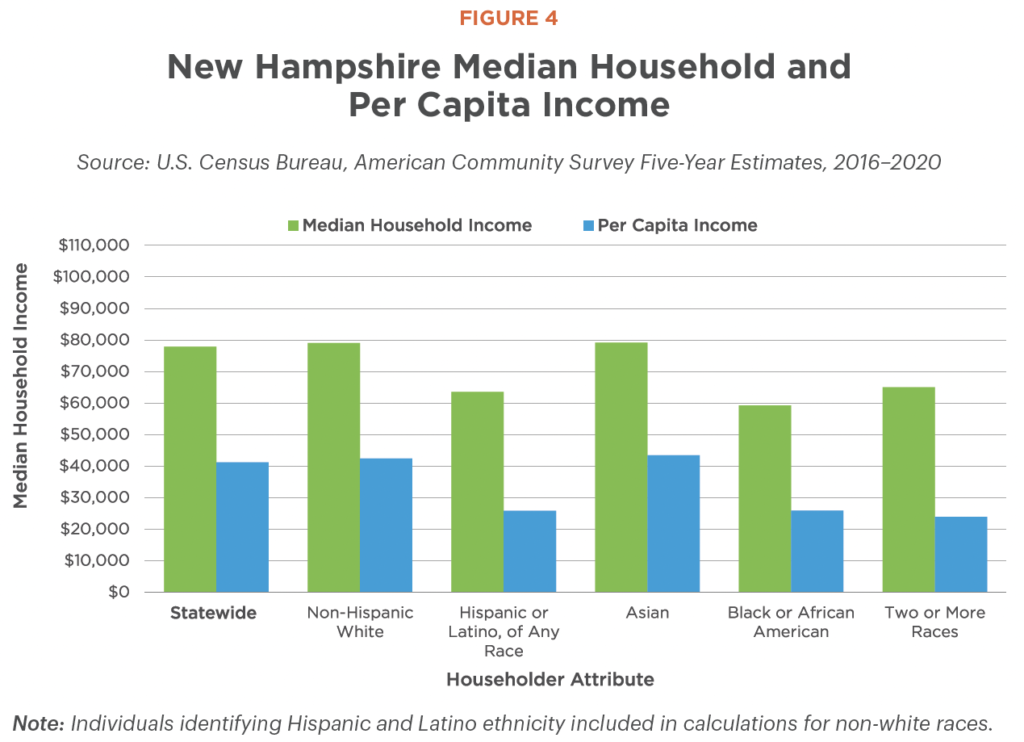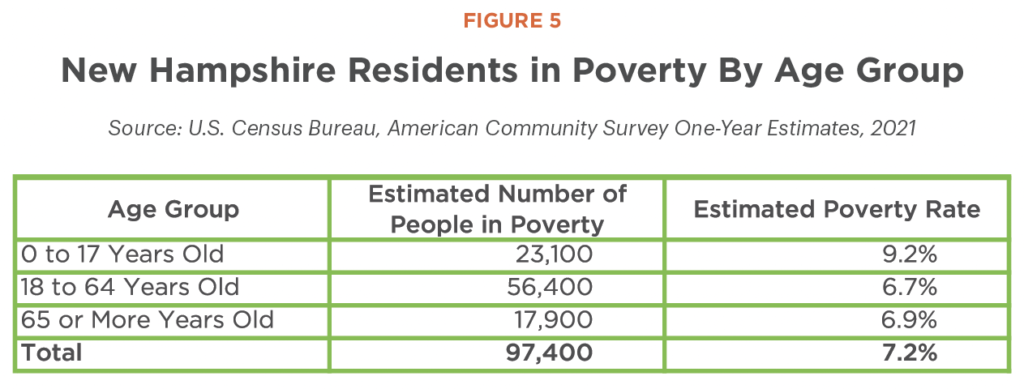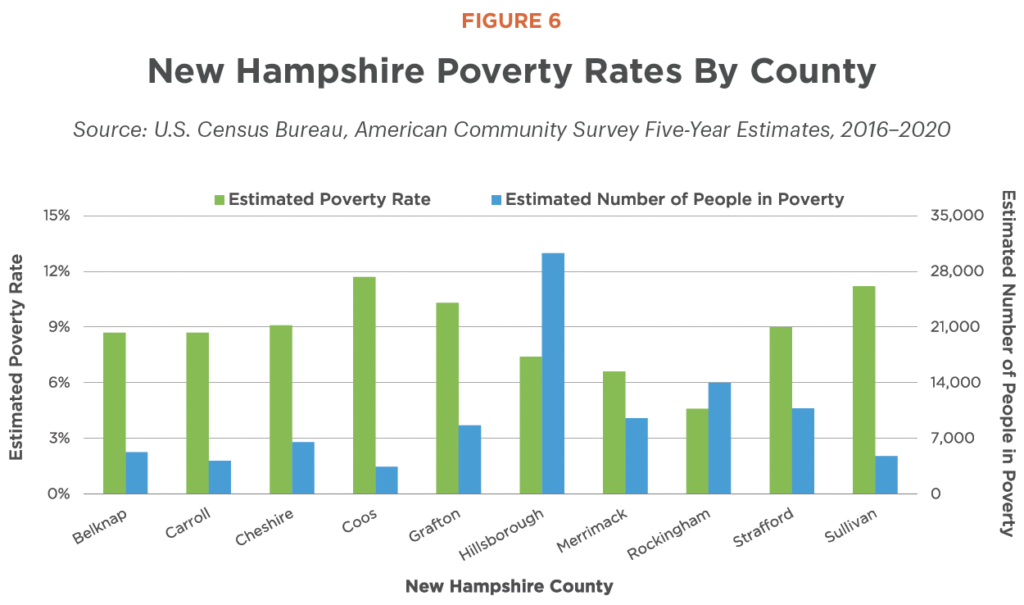This first edition of New Hampshire Policy Points provides an overview of the Granite State and the people who call New Hampshire home. It focuses on some of the issues that are most important to supporting thriving lives and livelihoods for New Hampshire’s residents.
New Hampshire Policy Points is intended to provide an informative and accessible resource to policymakers and the general public alike, highlighting areas of key concern. Touching on some important points but by no means comprehensive, each section within New Hampshire Policy Points includes the most up-to-date information available on each topic area as of October 2022.
The following section, Income and Economic Security, is one of nine sections that frame this resource guide. Other sections cover Population and Demographics, Economy and Jobs, Housing, Health, Education, Broadband Internet, Transportation, and How We Fund Public Services. The facts and figures included within this book provide useful information and references for anyone interested in learning about New Hampshire and contributing to making the Granite State a better place for everyone to call home.
To purchase a print copy or download a free digital PDF of New Hampshire Policy Points, visit nhfpi.org/policypoints
Compared to other states, New Hampshire has a relatively high median household income, although many Granite Staters with lower incomes face considerable difficulty making ends meet.
In 2021, the Granite State’s median household income was about $88,500 per year. Median household income, which tracks the middle level of income for all households, provides a valuable but incomplete picture of the economic circumstances facing New Hampshire families. In 2021, over one in four Granite State households had less than $50,000 per year in income, and more than one in six had less than $35,000.
In 2021, the median income for families with at least one child under 18 was about $114,900. Certain populations, however, had median incomes significantly lower than the statewide median, including families headed by single adults, individuals identifying as members of certain racial and ethnic minority groups, women, and people with fewer completed years of formal education. Households with at least one child under 18 and headed by a single female adult, for example, reported a median annual household income of about $37,400.
According to estimates from the United States Census Bureau, income inequality grew at a faster rate in New Hampshire from 2010 to 2019, during the recovery from the Great Recession, than in the nation overall. That suggests Granite Staters with lower or more modest incomes experienced increasing relative hardships during the last economic recovery. These Granite Staters are likely to have faced continued challenges making ends meet.
Poverty
As a state, New Hampshire has a relatively low level of poverty. Based on the official poverty measure, the estimated poverty rate in New Hampshire was 7.2 percent in 2021—the lowest in the nation. For those living in or near poverty, meeting basic, everyday household needs, such as food, clothing, and medical care, can present a significant challenge. Living in poverty means living below the federal poverty thresholds based on income. For households of one adult and no children, that threshold in 2021 was $13,788 per year; for households with two adults and two children, it was $27,479 per year. About 97,000 Granite Staters lived below the poverty thresholds in 2021.
Other measures indicate a higher relative poverty level in New Hampshire.
For example, the federal Supplemental Poverty Measure factors in additional expenses, including regional adjustments for housing costs. This measure shows that, from 2019–2021, New Hampshire’s poverty rate was statistically similar to eleven other states, including three that had lower poverty rate point estimates. This shows the official poverty measure may not fully reflect the relative cost of living for people with very low incomes or with more limited means in the state.
Poverty is more prevalent among certain groups of Granite Staters than others. Individuals identifying as members of certain racial and ethnic minority groups, or who are foreign- born, experience higher poverty rates. Additionally, households with children headed by a single woman have much higher rates of poverty in New Hampshire. Moreover, in 2021, about 9.2 percent of individuals under the age of 18 lived in poverty, compared to 6.9 percent of individuals over age 64. Poverty is also more prevalent among individuals with disabilities and individuals working part-time or not working.
Across New Hampshire, poverty rates also vary by geography. From 2016–2020, the poverty rate in Rockingham County was estimated to be about 4.6 percent, compared to the 11.7 percent poverty rate in Coos County. Furthermore, poverty rates within counties and municipalities can vary considerably. Communities with low concentrations of poverty may still have many residents in poverty due to the size of the population. For example, despite its relatively low poverty rate, Rockingham County had more residents in poverty than any New Hampshire county except for Hillsborough.
Cost of Living
The cost of living in certain areas provides key context when considering household incomes and challenges faced by those living in or near poverty. As prices for goods and services vary across different locations, the level of income families and individuals need to meet basic expenses also ranges across geographies. Researchers have provided estimates for the amount of income a family or individual would need to meet basic living costs in a particular location.
The 2021–2022 updates to the Massachusetts Institute of Technology (MIT) Living Wage Calculator estimated that the yearly expenses faced by a single adult in New Hampshire with no children would be $36,023. For a family with two working adults and one child, annual living costs would total $77,195. For a family with a single adult and two children, however, expenses would total about $88,506, in part due to increased child care costs. Separate calculations from the Economic Policy Institute (EPI) Family Budget Calculator, updated for 2022, estimated that a family of two adults and one child living in Hillsborough County, New Hampshire’s most populous region, would face yearly average expenses of $76,354, which is similar to the statewide MIT estimate. A family consisting of a single adult and two children living in Hillsborough County, based on the EPI Family Budget Calculator, would face average yearly expenses of $77,263.
Costs have been rising faster than usual for individuals and families in an economy still disrupted by the pandemic. Policy supports have helped many families meet these expenses, but many temporary policies designed in response to COVID-19 have either already expired or will end soon, leaving Granite Staters to face rising costs without that additional help.
• • •
This publication and its conclusions are based on independent research and analysis conducted by NHFPI. Please email us at info@nhfpi.org with any inquiries or when using or citing New Hampshire Policy Points in any forthcoming publications.
© New Hampshire Fiscal Policy Institute, 2022.




